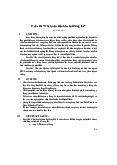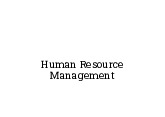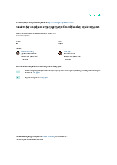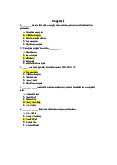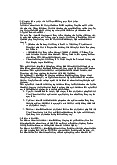



















Preview text:
CHAPTER 1: INTRODUCTION TO HUMAN RESOURCE MANAGEMENT
1. In order to enable an organization to compete in the 21st century, human resource
management needs to focus on .......
A. Developing production planning
B. Rationalizing scientific management principles
C. Developing a skillful and flexible workforce
D. Recruiting as many as possible employees
2. Below are the main activities of the HR Department EXCEPT.....
A. Directing operations manager
B. Giving services, advice and counseling
C. Developing and implementing organization policy
D. Administer recruitment and training programs
3. The key to quality product and services for an organization depends on how it manages...... A. Budget B. Project C. Labor union strictly D. Employees
4. The HR owned by an organization can be used to compete if the resource is ..... A. Paid special attention B. Well looked after C. Well managed D. Given attractive rewards
5. Which of these is Not one of the main technological effects towards human resource management?
A. Technology has changed the methods used to gather information of employee transfer
B. Technology has sped up the employee intake data processing
C. Technology has eliminated supervising roles in employee management
D. Technology has improved internal and external communications process
6. Which of the following is NOT considered one of the line supervisor's
responsibilities for effective human resources management under the general headings
outlined by a major company discussed in the textbook?
A. protecting employees' health and physical condition
B. changing employees' attitudes regarding work
C. developing the abilities of each person
D. interpreting the company policies and procedures
7. A line manager's human resource responsibilities most likely include all of the following EXCEPT ______.
A. maintaining department morale B. controlling labor costs
C. protecting employees' health
D. marketing new products and services
8. Which of the following refers to the authority a manager has to advise other managers or employees? A. staff authority B. line authority
C. functional authority D. corporate authority
Explanation: Functional authority refers to the authority exerted by an HR manager
ascoordinator of personnel activities. An HR manager ensures that line managers are
implementingthe firm's HR policies and practices. Line authority is a a manager's right
to issue orders to othermanagers or employees, which creates a superior-subordinate
relationship. Staff authority refersto a manager's right to advise other managers or
employees, which creates an advisoryrelationship.
CHAPTER 2: JOB ANALYSIS AND TALENT MANAGEMENT
1. Which term refers to a procedure for determining the duties and skill requirements
for a specific job and the kind of person most suitable for a position?
Thuật ngữ nào đề cập đến quy trình xác định các nhiệm vụ và yêu cầu kỹ năng cho
một công việc cụ thể và loại người phù hợp nhất cho một vị trí? A. HR management B. job description
C. job analysis (phân tích công việc) D. talent management
Explanation: Job analysis is the process of determining the duties of a specific job and
the characteristics of the people who would be most appropriate for the job. A job
analysis produces the necessary information to develop job descriptions and job specifications.
2. The information resulting from a job analysis is primarily used for writing ______.
Thông tin thu được từ phân tích công việc chủ yếu được sử dụng để viết
A. job descriptions (mô tả công việc) B. corporate objectives C. training requirements D. performance standards
Explanation: A job description is a list of what a job entails, and it is derived from a
job analysis. Job analysis is the procedure through which you determine the duties of
job positions and the characteristics of the people that should be hired for the positions.
3. During a job analysis, a human resources specialist will most likely collect
information about all of the following EXCEPT ______. A. human behaviors B. physical working conditions
C. responsibilities of the position
D. employee benefits options
4. Job analysis is most important because managers use it to ______. A. apply talent management
B. support all HRM activities
C. comply with ADA requirements
D. provide employment data to the government
5. Maria, an HR manager at ATX Manufacturing, needs to know what sorts of people
to recruit for a process engineering job at the firm. Which of the following would be most useful for Maria's task? A. job analysis B. organization chart C. industry standards D. performance appraisal
6. What is the first step in conducting a job analysis?
A. developing a job description
B. collecting data on job activities
C. deciding what information to collect
D. selecting representative positions to observe
7. Which of the following would LEAST likely involve the use of job analysis information? A. recruiting decisions B. training requirements C. performance appraisal
D. diversification oversight
8. Anna, a new employee at Concord Electronics, wants to make sure she understands
who to report to at the firm and the title of various positions. Which of the following would most likely help Anna?
A. organization chart B. workflow analysis C. process chart D. position analysis
9. Anita, an HR manager, is in the process of conducting a job analysis. She has just
finished selecting a sample of representative positions. What should Anita do next?
A. develop a job description that includes working conditions and responsibilities
B. contact supervisors to verify employees' tasks, responsibilities, and working conditions
C. interview employees to gather information about the job's duties and responsibilities
D. conduct a workflow analysis and develop a diagrammatic process chart for each job
10. What is the final step of the job analysis process? A. creating a process chart
B. writing a job description C. determining a sample group
D. verifying data with supervisors
CHAPTER 3: HUMAN RESOURCE PLANNING
1. ______ is the process of deciding what positions the firm will have to fill and how to fill them. A. Employee selection B. Talent management
C. Personnel planning D. Trend analysis
Explanation: Personnel or employment planning is the process of deciding what
positions the firm will have to fill and how to fill them. The process considers all
future positions from maintenance workers to executives, and flows from the firm's strategic plans.
2. What is the purpose of recruiting?
A. forecasting the supply of candidates
B. developing an applicant pool
C. establishing a strategic plan
D. developing qualifications inventories
3. Steve, an HR manager for IBM, must decide what positions the firm should fill in
the next 6 months, which means Steve is currently working on ______. A. candidate screening
B. workforce planning C. employee contracting D. department training
4. A firm's ______ should guide employment planning and determine the types of
skills and competencies the firm needs. A. organizational chart B. recruitment process C. marketing plan
D. strategic plan
Explanation: Employment planning should flow from the firm's strategic plans. For
example, plans to enter new businesses or reduce costs all influence the types of
positions a firm will need to fill or eliminate.
5. Which of the following is LEAST likely to be considered by employers during the process of workforce planning? A. personnel needs
B. organizational culture
C. supply of inside candidates
D. supply of outside candidates
6. Which of the following refers to studying variations in a firm's past employment
levels to predict future needs? A. ratio analysis
B. trend analysis C. job analysis D. graphical analysis
7. The process of making forecasts based on the relationship between some causal
factor like sales volume and the number of employees required is called ______.
A. ratio analysis B. trend analysis C. graphical analysis D. computer analysis
8. Newton Building Supplies hopes to generate an extra $4 million in sales next year.
A salesperson traditionally generates $800,000 in sales each year. Using ratio analysis,
how many new salespeople should Newton hire? A. 2 B. 5 C. 10 D. 12
9. A ______ shows graphically how two variables are related. A. trend analysis B. ratio analysis C. scatter plot D. correlation analysis
Explanation: A scatter plot graphically illustrates the relationship between two variables such
as sales and your firm's staffing levels.
10. ______ contain data on employees' performance records, educational backgrounds, and promotion recommendations.
A. Computerized forecasting tools B. Replacement charts
C. Qualifications inventories (kiểm kê trình độ)
D. HR scorecards (bản đồ chiến lược nhân sự)
11. What is the primary goal of the recruitment and selection process?
A. filling top executive positions
B. forecasting future personnel needs
C. hiring the best candidates for positions
D. increasing the retention of key employees
12. Theresa, an HR manager, works for a firm that is planning to expand overseas.
Theresa is in the process of workforce planning and has already forecasted the firm's
labor demand. What should Theresa do next?
A. create a job competencies matrix of all positions
B. establish training and development plans
C. identify labor supply-demand gaps
D. determine recruitment methods
CHAPTER 4: RECRUITMENT AND SELECTION
1. Hiring workers who have criminal backgrounds without proper safeguards is considered ______. A. improper screening
B. negligent hiring C. unreliable testing D. improper hiring
2. What is the primary goal of employee selection?
A. achieving person-job fit B. avoiding negligent hiring
C. developing a diverse workforce
D. maintaining valid test scores
3. As a manager, what is the most important reason to select employees carefully?
A. meet industry and organizational standards
B. comply with federal and state labor laws
C. improve personal and organizational performance
D. establish a high-performing work system
4. Effective employee screening will most likely ______.
A. improve team management skills
B. eliminate negative office politics
C. identify valid and reliable test procedures
D. reduce dysfunctional workplace behaviors
5. If a person scores a 70 on an intelligence test on one day and scores 110 when
retested on another day, you might conclude that this test is ______. A. Valid B. reliable C. unreliable D. inconsistent
6. If a person scores a 78 on a test on one day and scores a 79 when retested on
another day, you would most likely conclude that the test is ______. A. Valid B. invalid C. reliable D. unreliable
7. Which assessment method has a high development cost? A. cognitive ability tests B. job knowledge tests
C. structured interviews D. integrity tests
8. What is the purpose of recruiting?
A. forecasting the supply of candidates
B. developing an applicant pool
C. establishing a strategic plan
D. developing qualifications inventories
9. What type of screening device is designed to measure attitudes regarding tolerance of others who steal? A. personality tests B. interest inventories
C. paper-and-pencil honesty tests D. graphology
10. All of the following are guidelines for conducting an effective interview EXCEPT ______.
A. asking the candidate questions that require yes or no answers
B. showing courtesy and friendliness towards the candidate
C. scheduling a private room for the interview
D. taking brief notes during the interview
11. Which of the following is the most likely outcome of using the same questions
with all candidates being interviewed? A. revealing weaknesses B. managing time C. expressing interest D. reducing bias
12. Which question below is an example of a background question?
A. "Can you provide an example of a time when you developed a highly effective ad campaign?"
B. "What experience and training have you had with drafting designs for commercial buildings?"
C. "What is the procedure you would follow when examining a patient complaining of chest pain?"
D. "What steps would you follow to conduct a brainstorming session with a group of employees on safety?"
CHAPTER 5: TRAINING AND DEVELOPMENT
1. ______ provides new employees with the basic background information required to
perform their jobs satisfactorily. A. Employee recruitment B. Employee selection
C. Employee orientation D. Employee development
2. Which of the following would perform the initial orientation in most firms? A. HR specialist B. mid-level manager C. administrative assistant D. immediate supervisor
3. Maria was recently hired as an accountant with a large marketing firm. Today is
Maria's first day of work, and she will be attending an employee orientation session.
Which of the following is LEAST likely to be addressed during Maria's orientation? A. employee benefits B. daily routine C. safety measures D. sales methods
4. Which of the following is NOT one of the primary purposes of employee orientation?
A. The employee should become skilled with the firm's software.
B. The employee should understand the organization in a broad sense.
C. The employee should have a clear understanding of what is expected.
D. The employee should begin the process of learning the firm's preferences.
5) What is an alternative term for employee orientation? A. development B. acculturation C. recruiting D. onboarding
6) Which of the following terms refers to the methods used to give new or present
employees the skills they need to perform their jobs? A. orientation B. training C. development D. appraisal
7. Lucas, an HR manager, has been assigned the task of creating a training and
development program for his firm's employees. According to the ADDIE training
process model, what is the first step that Lucas should take?
A. assess the program's successes or failures B. design the program content
C. conduct a needs analysis
D. train the targeted group of employees
8. Anna, an HR manager, wants to determine the training needs of a new employee in
the shipping department. Which of the following would most likely help Anna? A. needs analysis B. task analysis C. performance analysis D. training analysis
9. In the ADDIE training process model, which of the following occurs immediately
after a needs analysis has been conducted?
A. assessing the program's successes or failures
B. presenting the program to a test audience
C. designing the overall training program
D. training a targeted employee group
10) Which of the following would most likely occur during the implementation stage of a training program?
A. presenting the program to a small test audience
B. designing the program content for different learners
C. conducting a needs analysis of newly hired workers
D. providing on-the-job training to the targeted group of employees
11. A performance analysis is primarily used to assess the training needs of ______. A. new employees B. prospective employees
C. current employees D. former employees
CHAPTER 6: PERFORMANCE APPRAISAL
1. The process of evaluating an employee's current and/or past performance relative to
his or her performance standards is called ______. A. Recruitment B. Employee selection
C. Performance appraisal D. Organizational development
2. Which of the following is NOT one of the recommended guidelines for setting effective employee goals? A. assigning specific goals B. assigning measurable goals
C. administering consequences for poor performance
D. encouraging employees to participate in setting goals
3. SMART goals are best described as ______.
A. specific, measurable, attainable, relevant, and timely
B. strategic, moderate, achievable, relevant, and timely
C. specific, measurable, achievable, relevant, and tested
D. straightforward, meaningful, accessible, real, and tested
4. All of the following are reasons for appraising an employee's performance EXCEPT ______.
A. assisting with career planning
B. making decisions about promotions
C. creating an organizational strategy map
D. determining appropriate salary and bonuses
5. In most organizations, which of the following is primarily responsible for
appraising an employee's performance?
A. employee's direct supervisor B. human resources manager C. EEO representative D. employee's peers
6. Which of the following is LEAST likely to be used by firms as an alternative source
of performance appraisal information? A. Peers B. Rating committees C. The employee
D. Outside experts
7. Setting work standards, assessing an employee's performance against those
standards, and providing employee feedback are the three steps of the ______. A. orientation process B. development analysis C. ratio analysis method
D. performance appraisal cycle
8. In order to be the most effective, the performance management process should occur ______. A. Occasionally B. continuously C. Periodically D. annually
9. Which performance appraisal technique lists traits and a range of performance for each? A. alternation ranking
B. graphic rating scale C. paired comparison D. constant sum rating scale
10. Which performance appraisal method involves distinguishing between the worst
and best employees based on a trait or traits?
A. alternation ranking B. graphic rating scale C. forced distribution D. constant sum rating scale
11. Suppose you have five employees to rate. You make a chart of all possible pairs of
employees for each trait being evaluated. Then, you indicate the better employee of
the pair for each pair. Finally, you add up the number of positives for each employee.
In this case, you have used the ______ method of performance appraisal. A. graphic ranking scale B. alternation ranking
C. paired comparison D. forced distribution
12. Which performance appraisal tool is being used by a supervisor who places
predetermined percentages of rates into various performance categories? A. graphic ranking scale B. alternation ranking
C. forced distribution D. paired comparison
13. Which of the following is one of the primary complaints regarding the use of the
forced distribution method for performance appraisals?
A. harm to employee morale B. high cost of administration
C. standardization of group sizes
D. time consuming to administer
14. Which performance appraisal tool involves a supervisor maintaining a log of
positive and negative examples of a subordinate's work-related behavior? A. alternation ranking B. constant sums rating C. narrative forms
D. critical incident
15. At M&M Enterprises, subordinates rate supervisor performances anonymously.
Which of the following refers to the process used at M&M? A. downward feedback
B. upward feedback C. paired evaluation D. peer evaluation
CHAPTER 7: STRATEGIC PAY PLAN & INCENTIVE PLANS
1. Which of the following terms refers to any salary increase the firm awards to an
individual employee based on his or her individual performance? A. merit pay B. variable pay C. competency-based pay D. incentive pay
2. How does merit pay differ from a bonus?
A. Merit pay becomes part of an employee's base pay, but a bonus does not.
B. A bonus becomes part of an employee's base pay, but merit pay does not.
C. Merit pay is linked to individual performance, while a bonus is linked to profits.
D. A bonus is linked to individual performance, while merit pay is linked to profits.
3. Which term refers to any plan that ties pay to productivity or profitability? A. piecework B. variable pay C. merit pay D. overtime pay
4. Workers at a t-shirt shop are paid a sum for each t-shirt they produce. Which
incentive plan is most likely used by the employer? A. merit pay B. piecework C. standard hour D. variable pay
5. What is the main benefit of paying salespeople a combination of salary and commission?
A. limiting the firm's risk of overly high commissions
B. aligning employee goals and company strategy
C. providing simple salary administration
D. clearly linking pay with performance
6. According to research, most firms use ______ to motivate the short- term performance of managers. A. work-life benefits
B. annual bonuses C. variable pay D. training
7. Which of the following involves setting a production standard for a specific work
group and then paying incentives to the group members if they exceed the standard?
A. team incentive plan B. group profit-sharing plan
C. employee stock ownership plan
D. organization-wide incentive plan
CHAPTER 8: BENEFITS & SERVICES
1. The primary purpose of ______ is to enable employees to balance work and family obligations. A. automated benefits systems B. work-life benefits C. cafeteria plans D. pooled paid leave banks
2. Which of the following provides services such as financial counseling, child care
referrals, and adoption assistance? A. long-term pension plan B. work-life benefit service C. benefit management system
D. employee assistance program
3. Which condition must be met for an injured employee to receive workers' compensation benefits?
A. The injury occurred during an overtime or nighttime shift.
B. The employee was wearing adequate protection.
C. The injury was not the fault of the employee.
D. The employee was injured while on the job.
4. Health insurance, life insurance, pensions, and child care assistance are best categorized as ______. A. compensation B. incentives C. benefits D. rewards
5. Keith works as a construction foreman, and he is viewed as a reliable, competent
employee. Keith was recently injured in a car accident while on vacation, and his
injuries are so severe that he will not be able to return to work. Which of the following
would most likely provide Keith with benefits?
A. supplemental unemployment benefits
B. workers' compensation insurance
C. unemployment insurance D. group life insurance
6. Which of the following terms refers to benefits for time not worked such as
unemployment insurance, vacation and holiday pay, and sick pay?
A. supplemental pay benefits B. employee assistance C. financial incentives D. merit pay
7. The indirect financial and nonfinancial payments employees receive for continuing
employment with the company are called ______. A. reimbursement B. employee compensation C. salary D. benefits
8. Kim works a 4-day workweek that consists of 10-hour days. Kim's employer most likely offers ______. A. job sharing B. flextime schedules C. telecommuting options
D. compressed workweeks
9. All of the following are Social Security benefits EXCEPT ______. A. death benefits B. disability payments C. retirement benefits
D. defined contribution benefits
10. Athena, a sales representative, was terminated from her position at Ross
Manufacturing. On Athena's last day of work, she was given a check for $5,000. What
did Athena most likely receive from Ross Manufacturing? A. disability pay B. annual bonus C. severance pay D. unemployment insurance
11. Elizabeth works at an auto firm, which recently shut down for five weeks to
change machinery. However, during the shutdown, Elizabeth was able to maintain her
standard of living because of the firm's ______.
A. supplemental unemployment benefits
B. workers' compensation insurance
C. supplemental health benefits D. disability insurance
12. Which of the following benefits is required by federal or state law?
A. disability insurance B. workers' compensation C. paid time off D. pensions
